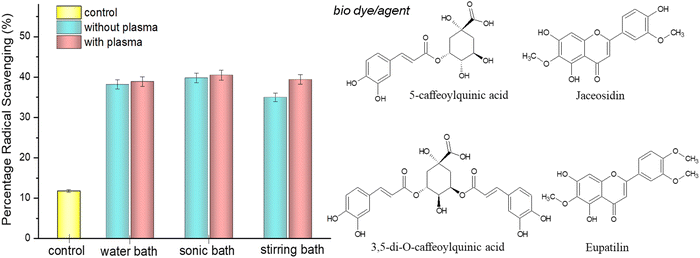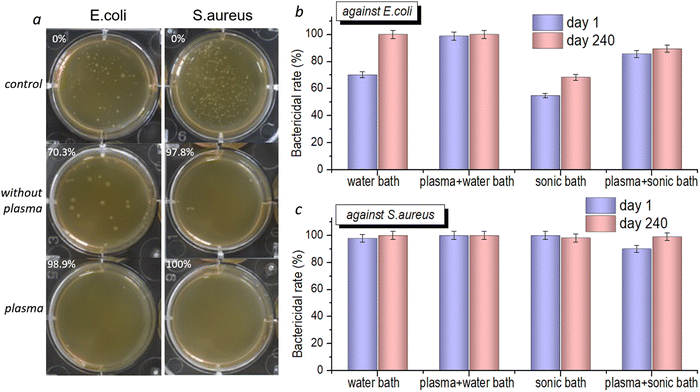 Open Access Article
Open Access ArticleCreative Commons Attribution 3.0 Unported Licence
Producing natural-colored super-powerful antibacterial cotton with plasma-assisted fiber surface modification: a green and effective cotton process for medical and healthcare applications
Zhonghua
Li
,
Yanyun
Zhang
,
Weibang
Xia
,
Yijun
Tang
and
Qing
Li
 *
*
State Key Laboratory of Silkworm Genome Biology, College of Sericulture, Textile and Biomass Science, Southwest University, Chongqing, 400715, China. E-mail: qingli@swu.edu.cn
First published on 11th January 2023
Abstract
Cotton is the most commonly used natural fiber with natural properties applicable to next-to-skin textiles. This study uses plasma fiber surface modification with soy protein coating with the aim of improving cotton's natural dyeing ability and functional finish from the herbal plant of F. Artemisiae argyi as a source of natural dye and bio-agent. The results showed that while soy coating alone can significantly increase the fibers’ natural dye uptake, fabric dyeing ability can be enhanced further when applying plasma pretreatment. When plasma pretreatment is applied to the fiber surface and at a soy concentration of above 3%, traditional water bath coating can exceed the ultrasonic bath in its effectiveness in attracting natural dye in the subsequent dyeing process. Plasma pretreatment followed by soy sonic coating can provide cotton with a soft handle whilst achieving improved color strength and UV protection. This study demonstrates a successful process of applying a biomedicinal agent to a cotton substrate, which can provide cotton with antioxidant properties and super powerful antibacterial (against S. aureus) ability with a bactericidal rate of 95–100%. The strong antibacterial activity remains powerful (or is even more powerful) after 8 months of storage. All materials used in this work are natural and are within easy access. The main achievement of this study is that by using low-cost natural compatible materials and green surface modification, traditional cotton material can broaden its applications in practical medicine/healthcare.
1 Introduction
Textiles are the final barrier in the protection of human skin from harmful intruders, such as viruses and bacteria. Cotton is one of the most important natural fibers in the world and has globally been the most produced natural fiber for centuries.1 Cotton is natural cellulose with hygroscopic and air permeable characteristics that make it a very comfortable next-to-skin textile, commonly used in bed sheets, underwear, handkerchiefs, towels, etc.The herbal plant F. Artemisiae argyi (FAA) is widely distributed in nature. Due to its good adaptability to climate and soil, it is very easily grown. FAA is quite often considered as a weed and is killed by weed killer. FAA plant, however, has had special medicinal significance since ancient China. It is a well-known traditional Chinese herbal medicine, commonly used in healthcare and clinics.2
Research into the natural dyeing of cotton has continued to draw attention over the past few years.3–8 When used as a natural dye/agent, FAA extracts were found difficult to be applied directly to cotton due to negative charges on the surface of natural cellulose fiber9 presenting repulsion to plant extracts, which also bear negative charges from polyphenolic compounds. Studies on the modification of the cotton cationic surface using synthetic agents or natural chemical compounds containing amines or amino acids have been conducted to overcome the problem. These have been recently summarized in a review.10
Soybean is vegetable-based and is rich in protein, and it is expected to form a complex with cotton fiber whilst providing the cotton surface with a cationic finish. It has, however, received little attention in applications as a mordanting agent. Recently, our research group has used soy as a cotton surface modification agent, and the mordanting process assisted by ultrasonics has proven to be effective in subsequent dyeing with natural dye.11 Alongside ultrasonics, plasma is a clean and effective technology in assisting textile dyeing and finishing. Plasma is a non-aqueous physical process used to improve textile surface properties, such as wettability, hydrophobicity, dyeability, and adhesion.12,13 Plasma is a partially ionized gas, composed of highly excited atomic, molecular, ionic and radical species with free electrons and photons. Common occurrences in the plasma treatment include surface etching, chain scission, polymer deposition and the formation of radicals, all of which can be interrelated and simultaneous.14 No water/solvent or extra chemicals are needed during the plasma process, and the treatment time is generally short (no more than a few minutes); therefore, it is regarded as an efficient and environmentally friendly technology.15,16
This study extends previous work to further investigate the possibility of using plasma pretreatment as a fiber surface modification, and its effectiveness in replacing ultrasonic bath coating, aiming to achieve effective and environmentally friendly cotton biofinishing.
All materials used in this work are natural-based and are within easy access at a very low cost. FAA, which can be easily found in the wild (such as river banks or roadsides), is used as a bio-agent and natural dye source. Soybean, used as a bio-mordant, is abundant in nature and is inexpensive. A simple water bath (with 50% ethanol) is used to extract natural bio-dye from FAA, instead of strong alkalines/acids or organic solvents (such as sodium hydroxide and acetone), which are commonly applied in natural dye extraction. No other chemicals are used in the process.
In Chinese medicine it is known that FAA is able to gain medicinal strength as the storage time is prolonged.17 Soy protein has the advantages of a relatively long shelf life and stability, making it a plant-derived macro-molecule compared to the various types of natural proteins used bioapplications.18 Therefore, the combination of plant-based FAA and soy is expected to provide cotton not only with natural compatibility, but with long-lasting powerful biofunction, such as antioxidant and antibacterial properties. These are investigated in detail in this study.
This work proposes an economical, efficient and green approach in the improvement of cotton biofunction and natural dyeing ability, aiming to impart a broader range of useful applications of traditional cotton material in the areas of healthcare and biomedicare.
2 Experimental
2.1 Materials and chemicals
Fabric (100% pure cotton, purchased from a local cotton mill) was used in this study. The water-soluble soy powder used was of food grade (lysine and methionine being the two major amino acids), supplied by Zhongtai Food Chemical Co., Ltd, China. FAA was sourced from market, and dried and ground into fine powder using an electric grinder after being cleaned and dried in an oven. Extraction was conducted in a 50% ethanol–water bath at 70 °C for 60 min, at a powder to liquor ratio of 1![[thin space (1/6-em)]](https://www.rsc.org/images/entities/char_2009.gif) :
:![[thin space (1/6-em)]](https://www.rsc.org/images/entities/char_2009.gif) 50. The preparation of FAA is shown in Fig. 1.
50. The preparation of FAA is shown in Fig. 1.
Ethanol (99%), acetic acid, sodium bicarbonate, sodium chloride, potassium persulphate (K2S2O8) and ABTS (2,2′-azino-bis(3-ethylbenzothiazoline-6-sulfonic acid)) used in antioxidant and antibacterial tests were of laboratory grade.
2.2 Equipment for plasma and coating baths
The equipment used for plasma pretreatment and soy bath coating as fiber surface modification are listed in Table 1. Two coating baths were examined in this study. Coating was conducted at a temperature of 50 °C for 60 min.| Treatment type | Equipment | Supplier | |
|---|---|---|---|
| Plasma pretreatment | Low temperature atmospheric pulse plasma instrument | Shanghai Textile Research Institute, China | |
| Soy bath coating | Water bath | SHZ-C constant temperature water bath | Nuoji Instrument Co., Ltd, China |
| Sonic bath | Ultrasonic water tank with temperature control | HS Ultrasonic Co., Ltd, China | |
2.3 Cotton dyeing/finishing process
Fabric surface modification was followed by dyeing, carried out in extracted FAA solution with a liquor to fabric ratio of 50![[thin space (1/6-em)]](https://www.rsc.org/images/entities/char_2009.gif) :
:![[thin space (1/6-em)]](https://www.rsc.org/images/entities/char_2009.gif) 1, at a dye bath pH of 5. The temperature of the bath was increased from room temperature of 25 °C to 85 °C at a heating rate of 2 °C min−1, and then maintained at 85 °C for 1.5 h. After dyeing, fabric samples were rinsed with deionized water before drying in the shade at room temperature. The process for treatment of the cotton fabric is presented in Fig. 1.
1, at a dye bath pH of 5. The temperature of the bath was increased from room temperature of 25 °C to 85 °C at a heating rate of 2 °C min−1, and then maintained at 85 °C for 1.5 h. After dyeing, fabric samples were rinsed with deionized water before drying in the shade at room temperature. The process for treatment of the cotton fabric is presented in Fig. 1.
2.4 Evaluation of fiber surface morphology
The surface morphology of fibers was examined using a Phenom ProX SEM (Nanoscience Instruments, Phoenix AZ, USA), under an extra high tension of 10 kV. The samples were coated with gold to enhance the electrical conductivity for capturing clear images.2.5 Measurement of fabric stiffness, contact angle, and crease recovery angle
Fabric stiffness (bending rigidity) was measured by a YG(B)022D automatic fabric stiffness tester (Darong Textile Instrument Co. Ltd, Wenzhou, China). Stiffness in mN·cm was calculated using eqn (1): | (1) |
Contact angle testing was conducted using an OCA15EC optical contact angle testing device (Dataphysics Ltd, Germany). The crease recovery angle was measured by a Digital Crease-recovery Tester YM541 (Yuanmao Instrument Ltd, Laizhou, China), following the standard GB/T3819-1997.
2.6 Determination of the fabric color strength (K/S) and UPF
The color strength (K/S) of dyed cotton fabrics was obtained using a Datacolor 650TM spectrophotometer (Datacolor SpectrumTM 152, USA). K/S values were calculated according to the Kubelka–Munk equation19 given in eqn (2). Ten measurements were conducted for each fabric sample and the results were averaged. | (2) |
The ultraviolet protection factor (UPF) of dyed cotton fabric was measured using an YG912E textile anti-ultraviolet performance tester (MEBON Co. Ltd, China), according to the EU standard 13758-2001. For each sample, at least five measurements were conducted, and the results were averaged.
2.7 Evaluation of antioxidant and antibacterial properties
Antioxidant activity was determined by the ABTS radical scavenging activity method described in a previous work.20 The antibacterial activity of dyed cotton fabrics was assessed using an absorption method in accordance with the testing standard GB/T 20944.2-2007. Escherichia coli (MTCC443, Gram-negative) and Staphylococcus aureus (MTCC902, Gram-positive) were used as experimental strains.2.8 Measurement of fabric color fastness and antibacterial shelf life
Wash fastness and rubbing fastness were evaluated following the standard testing methods of ISO 105-C06:1994 and ISO 105/X12:2001, using a DigiWASH-SS washer and a Digi CROCK crockmeter. Light fastness was tested according to the standard AATCC16-2003.Upon completing process, dyed fabric samples were measured for bactericidal rate within 1 day. Samples were then stored in a drawer at room temperature for 240 days before being taken out and again, measured for bactericidal rate using the same method described in 2.7 for comparison.
3 Results and discussion
3.1 Bio-dye/agent uptake assisted by fiber surface modification
The natural FAA bio-dye pickup rate during the process is examined by the color strength (K/S) of dyed fabrics. Fig. 2 shows the measurement results K/S of dyed fabrics (with and without plasma pre-treatment) as a function of soy coating. It is seen that plasma surface treatment alone (0% soy concentration) is not effective in natural dye adsorption. Upon coating with soy protein, fabric dye uptake is seen to be significantly increased in both of the coating baths investigated. It is seen from Fig. 2(a and b) that the K/S values rise progressively as soy concentration increases from 1% to 6%.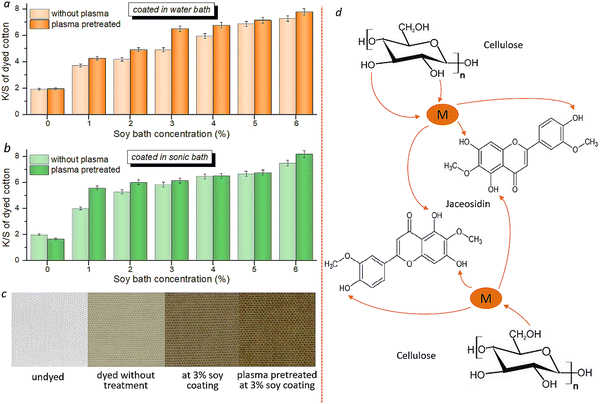 | ||
| Fig. 2 Color strength K/S (a and b), images of dyed fabrics as a function of soy protein coating (c), and interactions of the cellulose–mordant–dye complex (d). | ||
Soy protein is rich in amino acids. When used as a bio-mordant, it is able to form a cellulose–mordant–dye complex.11 A demonstration of the cellulose–dye interaction is shown in Fig. 2d, where the phenolic hydroxyl compound of jaceosidin found in FAA is used as an example of natural dye. Soy at a higher concentration produces a greater amount of protein (amino acid), which can result in a higher rate of fabric dye uptake. It can be seen from Fig. 2(a and b) that the soy protein-induced increase in fabric color strength can occur in the absence of plasma; however, it can be accelerated when plasma pretreatment is applied. Fig. 2c shows the images of a progressively deeper fabric shade as a result of plasma pretreatment and soy coating.
Fiber surface modification (Fig. 3a) is responsible for the observed increase in fiber dye uptake as a result of plasma pretreatment. An increased fiber wettability and fiber surface damage (etching) in the form of micro-cracks (indicated by arrows in Fig. 3a) can facilitate the entry of soy particles into fibers. The observed fiber surface micro-cracks as a result of plasma treatment are consistent with findings from a previous study.21 These results indicate that plasma-assisted soy coating can largely increase soy protein pick-up; therefore, fiber bio-dye affinity is enhanced to a great extent.
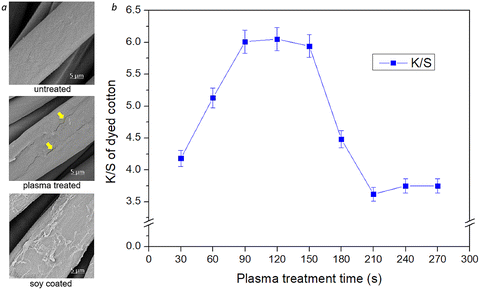 | ||
| Fig. 3 (a) SEM images of the fiber surface modified by plasma and coating and (b) color strength of dyed fabrics as a function of plasma pretreatment time, at a soy bath concentration of 3%. | ||
The effectiveness of soy coating as a function of plasma treatment time is shown in Fig. 3b, reflected by color strength (K/S) of dyed fabrics. It is seen that K/S of the fabrics increased with increasing treatment time for the first 90 s, and was maintained at a stable K/S level of around 6 before it started to decline at 150 s. Upon reaching 210 s, it again remained at a stable low K/S level of below 4. This observation can be related to the changes of fiber surface energy, which result in cotton wettability during plasma treatment.22 Soy adsorption on the fiber surface increased with increasing fiber wettability when the plasma treatment time was raised in the first 90 s and, as a result, fiber dye uptake was increased. This implied that 90 s is the ideal plasma treatment time for surface modification.
3.2 Effect of plasma and coating bath type
It has been shown previously that without plasma pretreatment, fabric mordanted in a ultrasonic bath can exhibit a better natural dye uptake than that in a traditional water bath.11 This is because in an ultrasonic bath, energy generated from cavitation implosion can result in an increased mordant pickup.23 The possibility of replacing ultrasonics with plasma pretreatment is examined in this work and the results are shown in Fig. 4. It can be seen that when the fabrics were pretreated with plasma (Fig. 4a), a noticeable increase for the water bath coating was observed, which exceeded that of the ultrasonic bath when the soy concentration reached 3% (indicated by an arrow in Fig. 4a) and remained the highest until 5%. This indicated that by applying the plasma pretreatment, a water bath can be just as efficient in achieving natural bio-dye uptake as the sonic bath.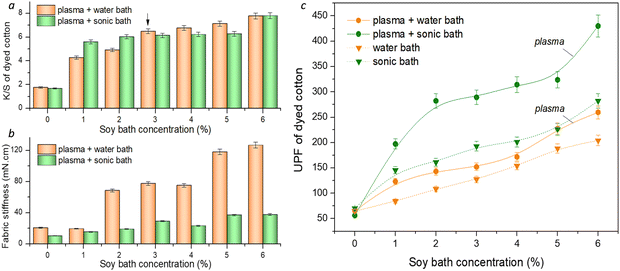 | ||
| Fig. 4 (a and b) Color strength K/S and stiffness of plasma pretreated dyed fabrics and (c) UPF of dyed fabrics in different coating baths, with and without plasma pretreatment. | ||
The results from the fabric handle (measured by stiffness) and UPF measurement, however, highlight the importance of sonic coating.
A soft fabric handle is an important contribution to the wearing comfort of a textile. As pointed out previously, higher fabric dye uptake can be achieved by applying soy at a higher concentration in the coating process. This increase in soy concentration, however, needs to be balanced, as heavy coating on the fiber surface can result in a stiff fabric handle. Fig. 4b shows the effect of the plasma pretreatment on the fabric stiffness as a function of soy concentration. Fabrics with water bath coating exhibit much higher values of stiffness than those of the sonic bath coating. This is due to the different weight gained by the fabric during the coating process. It can be seen from Table 2 that weight gain values for water bath-processed fabrics are double those of the sonic bath. Fabric crease recovery does not seem to be affected much, with plasma-treated samples showing a slightly improved crease recovery ability than those without plasma treatment.
| Sample | Weight gain (SD) (%) | Contact angle (SD) (°) | Fast recovery angle (SD) (°) | Slow recovery angle (SD) (°) | |
|---|---|---|---|---|---|
| Water bath | Without plasma | 4.6 (0.13) | 18.7 (1.7) | 109.8 (2.3) | 139.1 (2.9) |
| With plasma | 4.9 (0.16) | 14.7 (0.3) | 117.6 (2.7) | 143.8 (3.4) | |
| Sonic bath | Without plasma | 2.1 (0.06) | 38.9 (1.2) | 115.5 (1.7) | 141.4 (1.9) |
| With plasma | 2.4 (0.05) | 35.0 (0.7) | 119.4 (1.9) | 148.8 (2.5) | |
It is known that plasma surface treatment can result in a higher fiber hydrophilicity. This is confirmed by the contact angle test results shown in Table 2. As mentioned previously, plasma-induced fiber surface etching in the form of micro-cracks is able to provide soy/dye particles with extra paths to enter into fibers. This effect is accelerated with the help of ultrasonic irradiation, during which agglomerated soy particles were milled and disintegrated and driven by cavitation implosion in a speed-up movement. The results shown in Fig. 4b and Table 2 indicate that by using plasma pretreatment followed by ultrasonic coating, the soft fabric handle can be significantly improved compared to when coating in a traditional water bath.
In terms of the UPF of the dyed fabrics, it can be seen from Fig. 4c that under the same pretreatment condition, sonic coating has far greater UPF values than those of water bath coating. Fabrics with plasma pretreatment show higher UPF values than those of fabrics without plasma, regardless of the type of coating bath. It is seen that when coated with the sonic bath, the UPF values of plasma-pretreated samples almost doubled compared to those of samples without plasma. This could be due to strengthened interactions between the fiber surface and the natural dye as a result of plasma etching followed by ultrasonic irradiation.
3.3 Color fastness
It is known that natural colorants can be unstable when losing their natural origin of settlement. Poor wash fastness and light fastness are commonly seen in textile dyed with natural dye. The fixation and stability of the bio-dye/agent on the fiber surface thus become important in determining the quality of the final products.Table 3 shows the color fastness results of dyed fabrics (3% soy mordant). It is seen that wash fastness, rub fastness and light fastness of dyed samples, respectively, have a rating range of 3–4, 4–5, and 6–7, which are considered as satisfactory for natural dyeing and meet the industrial scale. The samples with plasma pretreatment in the ultrasonic bath have a slightly improved rub fastness and light fastness compared to the samples without plasma pretreatment. This can be explained by the improved connection between the natural dye and the fiber through plasma-assisted soy coating as the fiber surface modification, as analyzed previously.
| Sample | L* | a* | b* | Wash fastness | Rub fastness | Light fastness | ||
|---|---|---|---|---|---|---|---|---|
| Dry | Wet | |||||||
| Water bath | Without plasma | 65.23 | 2.44 | 24.33 | 3–4 | 5 | 4–5 | 6 |
| With plasma | 64.02 | 2.53 | 27.27 | 3–4 | 4–5 | 4–5 | 6 | |
| Sonic bath | Without plasma | 63.99 | 3.12 | 26.27 | 3–4 | 4–5 | 4–5 | 6 |
| With plasma | 63.27 | 2.24 | 26.94 | 3–4 | 5 | 5 | 6–7 | |
3.4 Biofunction of processed cotton
Fig. 6(b and c) presents the antibacterial shelf life of dyed cotton measured after 240 days (8 months) compared to the results from day 1. It is surprising and interesting to find that after 8 months, the cotton produced in this work has not at all lost its powerful bacteria removal functions, neither against E. coli nor S. aureus.
With soy coated in the water bath (regardless of plasma pretreatment), the samples showed a complete bacteria removal rate of 100% against E. coli and S. aureus after 8 month (Fig. 6(b and c)). Washing tests showed an antibacterial capacity of 86% after 5 washes of the fabric, which is still considered satisfactory. These results are rather exciting and can be referred to the bioactive volatile matter within the FAA extracts. A longer storage time allowed full volatilization and, hence, better curing of the chemicals on the fiber surface. Meanwhile, soy is a non-animal natural protein with long storage time, stability and biofunction.18 It is believed that vegetable-based soy protein used as a bio-mordant in this work also contributed to the long shelf life of the bio-dyed/finished cotton. Future work will be needed to see how much longer the antibacterial activity can be retained before it eventually declines.
S. aureus is a type of bacteria commonly found in skin infections. By examining the antibacterial shelf life, the concern that fabric biofunction may be weakened over time was removed. The super powerful antibacterial cotton with a long shelf life is expected to provide broader and value-adding applications to traditional cotton material in the area of health and medical care. These include applications to next-to-skin cotton textiles, such as underwear, handkerchiefs and towels, as well as medical textiles, such as gauze, medical bandages, surgical gowns, face masks, etc.
4 Conclusion
The applicability of plasma surface modification and soy protein coating is investigated in this work in an attempt to broaden the application of natural bio-dye/agent from the medicinal plant of FAA to traditional cotton for its usage in medical and healthcare areas. It is shown that while soy coating alone can significantly increase fiber natural dye uptake, the fabric dyeing ability can be enhanced further when plasma pretreatment is applied. When plasma pretreatment is applied to the fiber surface and at a soy concentration of above 3%, traditional water bath coating can exceed the ultrasonic bath in its effectiveness to attract natural dye in the subsequent dyeing process. Fabric plasma pretreatment followed by ultrasonic soy coating can provide cotton fabric with a soft handle and a high level of UV protection.This work presented a green, biofunctional dyeing and finishing process of cotton with antioxidant properties and powerful antibacterial ability. An outstanding anti S. aureus cotton product has been shown to exhibit a long shelf life, with a bactericidal rate of 98–100% measured in all cases even after 8 months of storage, owing to the inherent pharmacological properties of FAA used as a natural bio-dye/agent, as well as the vegetable protein of soy used as a bio-coating agent. The outcomes of this study can potentially widen the application of traditional cotton material to more practical healthcare/medicare applications.
Conflicts of interest
There are no conflicts to declare.Acknowledgements
Support of this study from the Chongqing Overseas Scholars Innovation Program (project ID: cx2018025) is acknowledged by the authors.References
- H. Wang and H. Memon, Cotton Science and Processing Technology, Springer, 2020 DOI:10.1007/978-981-15-9169-3.
- Z. Z. Li, J. L. Lv, L. B. Zhang and H. H. Zhu, Chemical constituents and pharmacology activities of Artemisia argyi: research advances, Int. J. Pharm. Res., 2016, 43, 1059–1066, DOI:10.13220/j.cnki.jipr.2016.06.007.
- U. Baig, A. Khatri, S. Ali, N. Sanbhal, F. Ishaque and N. Junejo, Ultrasound-assisted dyeing of cotton fabric with natural dye extracted from Marigold flower, J. Text. Inst., 2021, 112, 801–808, DOI:10.1080/00405000.2020.1779907.
- F. Giacomini, A. A. U. de Souza and M. de Barros, Cationization of cotton with ovalbumin to improve dyeing of modified cotton with cochineal natural dye, Text. Res. J., 2020, 90, 1805–1822, DOI:10.1177/0040517519899652.
- R. Naveed, I. A. Bhatti, S. Adeel, A. Ashar, I. Sohail, M. U. Khan, N. Masood, M. Iqbal and A. Nazir, Microwave-Assisted Extraction and Dyeing of Cotton Fabric with Mixed Natural Dye from Pomegranate Rind (Punica Granatum L.) and Turmeric Rhizome (Curcuma Longa L.), J. Nat. Fibers, 2022, 19, 248–255, DOI:10.1080/15440478.2020.1738309.
- Sukemi, K. Pratumyot, C. Srisuwannaket, N. Niamnont and W. Mingvanish, Dyeing of cotton with the natural dye extracted from waste leaves of green tea (Camellia sinensis var. assamica), Color. Technol., 2019, 135, 121–126, DOI:10.1111/cote.12381.
- A. Nazari, Superior Self-cleaning and Antimicrobial Properties on Cotton Fabrics Using Nano Titanium Dioxide along with Green Walnut Shell Dye, Fibers Polym., 2019, 20, 2503–2509, DOI:10.1007/s12221-019-1135-7.
- H. Jiang, R. Guo, R. Mia, H. Zhang, S. Lü, F. Yang, S. Mahmud and H. Liu, Eco-friendly dyeing and finishing of organic cotton fabric using natural dye (gardenia yellow) reduced-stabilized nanosilver: full factorial design, Cellulose, 2022, 29, 2663–2679, DOI:10.1007/s10570-021-04401-9.
- K. Stana-Kleinschek and V. Ribitsch, Electrokinetic properties of processed cellulose fibers, Colloids Surf., A, 1998, 140, 127–138, DOI:10.1016/s0927-7757(97)00301-4.
- Y. Y. Zhang, I. Shahid ul, L. J. Rather and Q. Li, Recent advances in the surface modification strategies to improve functional finishing of cotton with natural colourants-A review, J. Cleaner Prod., 2022, 335, 130313, DOI:10.1016/j.jclepro.2021.130313.
- Y. Y. Zhang, Q. Zhou, W. B. Xia, L. J. Rather and Q. Li, Sonochemical mordanting as a green and effective approach in enhancing cotton bio natural dye affinity through soy surface modification, J. Cleaner Prod., 2022, 336, 130465, DOI:10.1016/j.jclepro.2022.130465.
- N. V. Bhat, A. N. Netravali, A. V. Gore, M. P. Sathianarayanan, G. A. Arolkar and R. R. Deshmukh, Surface modification of cotton fabrics using plasma technology, Text. Res. J., 2011, 81, 1014–1026, DOI:10.1177/0040517510397574.
- C. W. Kan, C. F. Lam, C. K. Chan and S. P. Ng, Using atmospheric pressure plasma treatment for treating grey cotton fabric, Carbohydr. Polym., 2014, 102, 167–173, DOI:10.1016/j.carbpol.2013.11.015.
- R. Abd Jelil, A review of low-temperature plasma treatment of textile materials, J. Mater. Sci., 2015, 50, 5913–5943, DOI:10.1007/s10853-015-9152-4.
- A. Zille, F. R. Oliveira and A. P. Souto, Plasma Treatment in Textile Industry, Plasma Processes Polym., 2015, 12, 98–131, DOI:10.1002/ppap.201400052.
- A. Haji and M. Naebe, Cleaner dyeing of textiles using plasma treatment and natural dyes: A review, J. Cleaner Prod., 2020, 265, 121866, DOI:10.1016/j.jclepro.2020.121866.
- Z. Y. He, Y. H. Zhang, D. Wei, R. H. Yu, H. H. Yuan and M. B. Lan, Chemical composition of essential oil from fresh and dried Folium Artemisia argyi from Hubei Province, Chin. Tradit. Pat. Med., 2009, 31, 1079–1082 CAS.
- S. S. Silva, J. M. Oliveira, H. Sá-Lima, R. A. Sousa, J. F. Mano and R. L. Reis, Polymers of Biological Origin, Compr. Biomater., 2011, 2, 187–205, DOI:10.1016/B978-0-08-055294-1.00069-6.
- J. Shen, Y. Li and J. H. He, On the Kubelka-Munk absorption coefficient, Dyes Pigm., 2016, 127, 187–188, DOI:10.1016/j.dyepig.2015.11.029.
- Q. Zhou, L. J. Rather, A. Ali, W. C. Wang, Y. Y. Zhang, Q. M. R. Haque and Q. Li, Environmental friendly bioactive finishing of wool textiles using the tannin-rich extracts of Chinese tallow (Sapium sebiferum L.) waste/fallen leaves, Dyes Pigm., 2020, 176, 108230, DOI:10.1016/j.dyepig.2020.108230.
- M. Naebe, Q. X. Li, A. Onur and R. Denning, Investigation of chitosan adsorption onto cotton fabric with atmospheric helium/oxygen plasma pre-treatment, Cellulose, 2016, 23, 2129–2142, DOI:10.1007/s10570-016-0915-0.
- K. N. Pandiyaraj and V. Selvarajan, Non-thermal plasma treatment for hydrophilicity improvement of grey cotton fabrics, J. Mater. Process. Technol., 2008, 199, 130–139, DOI:10.1016/j.jmatprotec.2007.07.046.
- Y. Pan, W. C. Wang, K. Gong, C. J. Hurren and Q. Li, Ultrasonic scouring as a pretreatment of wool and its application in low-temperature dyeing, Text. Res. J., 2019, 89, 1975–1982, DOI:10.1177/0040517518783348.
- L. J. Rather, Q. Zhou, A. Ali, Q. M. R. Hague and Q. Li, Valorization of Natural Dyes Extracted from Mugwort Leaves (Folium artemisiae argyi) for Wool Fabric Dyeing: Optimization of Extraction and Dyeing Processes with Simultaneous Coloration and Biofunctionalization, ACS Sustainable Chem. Eng., 2020, 8, 2822–2834, DOI:10.1021/acssuschemeng.9b06928.
- J. L. Lv, J. A. Duan, B. Shen and Y. Y. Yin, Caffeic Acid Esters from Artemisia argyi and their Antioxidant Activities, Chem. Nat. Compd., 2013, 49, 8–11, DOI:10.1007/s10600-013-0492-5.
- N. Zhao, Y. Xin and C. L. Zhang, Inhibitory effect of extracts from Artemisia argyi leaves on bacterial skin pathogenic bacteria, Chin. Herb. Med., 2008, 01, 107–110, DOI:10.13863/j.issn1001-4454.2008.01.041.
| This journal is © The Royal Society of Chemistry 2023 |


